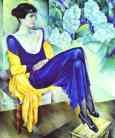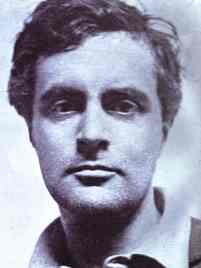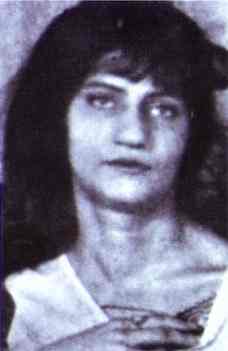Olga's Gallery
Dear Friends of Art,
In August 2002 we published the collection of Amedeo
Modigliani, an Italian painter of the beginning of the 20th century.
During his short, unbalanced and chaotic life he managed to create masterpieces,
that are highly praised nowadays by art lovers and collectors; actually
Modigliani's works are among the most expensive ones.
It was difficult to work on his biography, because on one hand, there
are a lot of books about the artist, full of legends of all kinds, on the
other hand, there are not many facts about him.
The topic of today’s letter, one of Modigliani’s love affairs, is also
based on very few facts, which we interpreted in our way, you may have
your own version.
Anna and Amedeo
In 1910 Russian poet Nikolai Gumilev brought his young wife, also a poet, Anna Akhmatova, to Paris. The couple came on their honeymoon.
 She
was tall, slender and very graceful, always and everywhere she attracted
glances; Parisiens, a strange folk, openly expressed their admiration of
her very uncommon beauty. Gumilev, who adored her but whose love was not
reciprocal, was a little jealous, but he understood, that it was a local
way and tried to be polite. Only one’s man admiration suddenly aroused
open irritation. The man’s name was Amedeo Modigliani.
She
was tall, slender and very graceful, always and everywhere she attracted
glances; Parisiens, a strange folk, openly expressed their admiration of
her very uncommon beauty. Gumilev, who adored her but whose love was not
reciprocal, was a little jealous, but he understood, that it was a local
way and tried to be polite. Only one’s man admiration suddenly aroused
open irritation. The man’s name was Amedeo Modigliani.
 How
did they get acquainted with Modigliani? When Anna recalled their first
encounter years later for other people, she always told a different story,
she was creating a myth, she liked myths, like her Italian friend. Most
probably they were introduced to each other by one of their mutual Russian
friends, the community of Russian artists, poets, and writers was rather
big and Modigliani had many friends among them. Half a century later in
her memoirs she would write that she met Amedeo in the spring of 1910,
but saw him only a few times. During these “few times” she fell in love,
maybe he too, because he wrote to her in St. Petersburg through the rest
of 1910 and the winter and spring of 1911. “I remember just a few sentences
from his letters, one of them ‘Vous etes en moi comme une hantise’ (You
are my obsession),” remembered Akhmatova. Some art historians date his
nudes of her to the spring of 1910. But that seems improbable. Though willful
she was, she was afraid of leaving her husband, who loved her so much,
she constantly felt guilty for having feelings towards another man. Still,
yes, that was a strange honeymoon.
How
did they get acquainted with Modigliani? When Anna recalled their first
encounter years later for other people, she always told a different story,
she was creating a myth, she liked myths, like her Italian friend. Most
probably they were introduced to each other by one of their mutual Russian
friends, the community of Russian artists, poets, and writers was rather
big and Modigliani had many friends among them. Half a century later in
her memoirs she would write that she met Amedeo in the spring of 1910,
but saw him only a few times. During these “few times” she fell in love,
maybe he too, because he wrote to her in St. Petersburg through the rest
of 1910 and the winter and spring of 1911. “I remember just a few sentences
from his letters, one of them ‘Vous etes en moi comme une hantise’ (You
are my obsession),” remembered Akhmatova. Some art historians date his
nudes of her to the spring of 1910. But that seems improbable. Though willful
she was, she was afraid of leaving her husband, who loved her so much,
she constantly felt guilty for having feelings towards another man. Still,
yes, that was a strange honeymoon.
“We both did not understand one very important thing – everything,
that happened, was for both of us a pre-history of our lives – his, very
short, and mine – very long.” (Akhamatova)
 The
Gumilevs returned to Russia and Nikolai brought his wife to his mother’s
estate. The old estate with its strict order and discipline quite unexpectedly
gave peace and freedom to Anna, who could wander in the surrounding woods
and fields for hours, thinking and dreaming, turning her feelings into
poems. On the contrary, it bored and irritated Nikolai. In two months he
left for Africa. And Amedeo wrote her love letters, “You are my obsession’…
She wrote love verses about her obsession with him. Those are lyrical Russian
verses, they could not be addressed to him as he did not know Russian,
he could not understand them, these are Russian verses addressed to an
idol with Modigliani’s appearance… “Modigliani was very sorry he could
not understand my poems.” (Akhmatova)
The
Gumilevs returned to Russia and Nikolai brought his wife to his mother’s
estate. The old estate with its strict order and discipline quite unexpectedly
gave peace and freedom to Anna, who could wander in the surrounding woods
and fields for hours, thinking and dreaming, turning her feelings into
poems. On the contrary, it bored and irritated Nikolai. In two months he
left for Africa. And Amedeo wrote her love letters, “You are my obsession’…
She wrote love verses about her obsession with him. Those are lyrical Russian
verses, they could not be addressed to him as he did not know Russian,
he could not understand them, these are Russian verses addressed to an
idol with Modigliani’s appearance… “Modigliani was very sorry he could
not understand my poems.” (Akhmatova)
As soon as Nikolai returned from Africa, Anna left for Paris. She went
to Amedeo. He was occupied with sculpture at the time and was fond of Egypt.
“He took me to the Louvre, its Egyptian department… Drew my head in decoration
of Egyptian tsarinas and dancers and seemed to be fully occupied with the
art of Egypt.”
He adored her long neck and elongated body. Who knows, he was in love
because her forms answered his aesthetic ideal, or vice versa, her shape
influenced the stylistics of his works, made them so recognizable, “neo-manneristic”?
 “Modigliani
subjects Jeanne entirely to his style” an art historian, Doris Krystof,
writes about the painter’s common-law wife, Jeanne Hebuterne. Yes,
on the photo Jeanne looks rather broad faced, in life she was well-built,
but short, petite. Anna’s body was not needed to be subjected to the style,
it fully answered his future style.
“Modigliani
subjects Jeanne entirely to his style” an art historian, Doris Krystof,
writes about the painter’s common-law wife, Jeanne Hebuterne. Yes,
on the photo Jeanne looks rather broad faced, in life she was well-built,
but short, petite. Anna’s body was not needed to be subjected to the style,
it fully answered his future style.
“Modigliani liked to wander about Paris at night, and often, when
I heard his steps in the dreamy silence of the street, I used to come up
to a window and through jalousie follow his shadow which slowed under my
window.” That’s all. Even 50 years later her prose about him is decent
and decorous.
The truth is, however, in her passionate verses.
| Ìíå ñ òîáîþ ïüÿíûì âåñåëî -
Ñìûñëà íåò â òâîèõ ðàññêàçàõ. Îñåíü ðàííÿÿ ðàçâåñèëà Ôëàãè æåëòûå íà âÿçàõ. Îáà ìû â ñòðàíó îáìàííóþ Çàáðåëè è ãîðüêî êàåìñÿ, Íî çà÷åì óëûáêîé ñòðàííîþ È çàñòûâøåé óëûáàåìñÿ? Ìû õîòåëè ìóêè æàëÿùåé Âìåñòî ñ÷àñòüÿ áåçìÿòåæíîãî... Íå ïîêèíó ÿ òîâàðèùà È áåñïóòíîãî è íåæíîãî |
When you're drunk it's so much fun --
Your stories don't make sense. An early fall has strung The elms with yellow flags. We've strayed into the land of deceit And we're repenting bitterly, Why then are we smiling these Strange and frozen smiles? We wanted piercing anguish Instead of placid happiness. . . I won't abandon my friend, So dissolute and mild. |
-- translated by Judith Hemschemeyer
Originally published (in Russian) in the book Evening, 1912
 The
truth is in Anna’s jealousy and irritation with all his other women, especially
the one, Beatrice Hastings. The strange love affair between Modigliani
and Hastings lasted for nearly 2 years. Beatrice was a journalist, a poetess,
a circus artist, a follower of Blavatsky, talented spiritual medium… She
wrote of Modigliani, “A complex character. A swine and a pearl”. “I read
in an American essay,’ writes Akhmatova, ‘that one Beatrice Hastings made
a strong influence on Modigliani… I can, and think it’s necessary, to state,
that he was well educated long before his meeting with Beatrice… And I
doubt that a woman, who calls the great painter a swine, can enlighten
somebody.” Anna could not forgive the unknown rival the word ‘swine’.
The
truth is in Anna’s jealousy and irritation with all his other women, especially
the one, Beatrice Hastings. The strange love affair between Modigliani
and Hastings lasted for nearly 2 years. Beatrice was a journalist, a poetess,
a circus artist, a follower of Blavatsky, talented spiritual medium… She
wrote of Modigliani, “A complex character. A swine and a pearl”. “I read
in an American essay,’ writes Akhmatova, ‘that one Beatrice Hastings made
a strong influence on Modigliani… I can, and think it’s necessary, to state,
that he was well educated long before his meeting with Beatrice… And I
doubt that a woman, who calls the great painter a swine, can enlighten
somebody.” Anna could not forgive the unknown rival the word ‘swine’.
Akhmatova and Modigliani kept their affair secret, she was afraid to go with him to places where she could meet people who knew her husband, he liked mysteries and did not insist.
 “He
never drew me from life…,” she writes playfully. Of course at the age of
70 she wanted her youthful love affair to look respectable. He gave
her 16 paintings of her, but she kept only one, decent and seemly. Where
are the remaining 15? She said that they were destroyed during the Revolution.
But were they? Did she bring them to Russia? The only one, which she brought,
she hid too. She concealed all evidence of her Parisian affair from her
husband. Only once she mentioned Modigliani’s name in front of Gumilev
in May of 1918, and his reaction was immediate and negative, he called
the painter ‘drunk beast’. “And they both had only three years of life
ahead and big posthumous fame,” she comments sadly. (Amedeo would die in
January 1920, and Nikolai would be shot by Bolsheviks in 1921 as a counter-revolutionary.)
“He
never drew me from life…,” she writes playfully. Of course at the age of
70 she wanted her youthful love affair to look respectable. He gave
her 16 paintings of her, but she kept only one, decent and seemly. Where
are the remaining 15? She said that they were destroyed during the Revolution.
But were they? Did she bring them to Russia? The only one, which she brought,
she hid too. She concealed all evidence of her Parisian affair from her
husband. Only once she mentioned Modigliani’s name in front of Gumilev
in May of 1918, and his reaction was immediate and negative, he called
the painter ‘drunk beast’. “And they both had only three years of life
ahead and big posthumous fame,” she comments sadly. (Amedeo would die in
January 1920, and Nikolai would be shot by Bolsheviks in 1921 as a counter-revolutionary.)
In two months Anna and Amedeo parted, not to meet ever again, she returned
to St. Petersburg and he stayed in Paris… Now they ascended separately
each to his own fame.
| Ïåñíÿ ïîñëåäíåé âñòðå÷è
Òàê áåñïîìîùíî ãðóäü õîëîäåëà.
Ïîêàçàëîñü, ÷òî ìíîãî ñòóïåíåé,
ß îáìàíóò ìîåé óíûëîé,
È ÿ òîæå. Óìðó ñ òîáîé...”
|
Song of the Last Meeting
My heart froze helplessly.
It seemed that there were so many steps,
I’m deceived by my cheerless
Me too. I’ll die with you…”
|
(The strange thing is that another young lover of Modigliani, Jeanne Hebuterne, would really die with him…)
These verses became so popular in Russia, that later Akhmatova hated
them. “I don’t understand why these poor poems of a shallow girl are re-published”
so many times, she would write about her poems of 1910-1911.
In 1940 Akhmatova started a big poem, “Poem without a Hero”. In one
of the working variants she has the following lines, where she called her
first lover by name:
|  ÷åðíîâàòîì Ïàðèæ òóìàíå,
È íàâåðíî, îïÿòü Ìîäèëüÿíè Íåçàìåòíî áðîäèë çà ìíîé. Ó íåãî ïå÷àëüíîå ñâîéñòâî Äàæå â ñîí ìîé âíîñèòü ðàññòðîéñòâî È áûòü ìíîãèõ áåäñòâèé âèíîé. |
Paris is in dark mist
And probably again Modigliani Imperceptibly follows me. He has a sad virtue To bring disorder even to my dreams And be the reason of my many misfortunes. |
Nobel Prize laureate and a close friend of Akhmatova, Joseph Brodsky,
said concerning Akhmatova’s essay about Modigliani, “It’s Romeo and Juliet
played by persons of royal blood”. Akhmatova laughed, she liked the joke,
and she saw that those who can read understood her restrained story pretty
well.
Bibliography:
Poems. By Anna Akhmatova. Leningrad. 1989.
Amedeo Modigliani. By Anna Akhmatova. In Prose of the Poet.
Moscow. 2000.
Russian Secrets of Paris. By B. Nosik. St. Petersburg. 2001.
We also published a collection of works of Russian painter Nathan Altman, who painted a famous portrait of Anna Akhmatova.
We would be glad to receive your opinions and comments on our newsletters.
Please write to freeart@freeart.com